A One-Dimensional Nonlinear Consolidation Analysis of Double-Layered Soil with Continuous Drainage Boundary
Abstract
:1. Introduction
2. Fundamental Problems
3. Difference Solution
4. Verification and Analysis of Solution
4.1. Verification of Solution
4.2. Consolidation Analyses
5. Conclusions
- When the permeability of the lower soil is higher than that of the upper soil, or the compressibility of the lower soil is lower than that of the upper soil, it is beneficial to the consolidation of the foundation.
- Exchanging interface parameters between the upper and lower soil layers yields limited impact when their compressibility and permeability exhibit similarity. Nevertheless, notable effects emerge when the compression index to penetration index ratio deviates across these layers, leading to substantial variations in soil consolidation rates. Given that layered soil typically displays heterogeneous properties, the interface parameters, i.e., the interface permeability on consolidation and settlement calculations, are of considerable significance and cannot be disregarded in most instances.
- For , both the average degree of consolidation defined by settlement (Us) and pore water pressure (Up) increase with rising Nσ values. Furthermore, the effect of Nσ on (Us) is more pronounced than on (Up) under continuous boundary conditions.
- In cases where , the Us increases with increasing Nσ values under continuous boundary conditions. This contradicts the existing outcome based on the traditional Terzaghi drainage boundary, where changes in Nσ had no effect on the Us consolidation curve. In cases where , Up decreases with increasing Nσ values. The influence of Nσ on Us is multifaceted: during early consolidation, Us increases with rising Nσ, but in the middle and later stages of consolidation, Us decreases with increasing Nσ.
- Unlike the consolidation characteristics under traditional boundary conditions, in the case of continuous drainage boundary conditions, the pore pressure at the boundary interface is no longer consistently maintained at zero. As the interface parameters decrease, the pore pressure at the interface gradually increases, and the rate of pore pressure dissipation progressively decreases. Furthermore, the pore pressure diminishes as both a and b values decrease proportionally, indicating that in foundations where the upper layer exhibits better permeability and the lower layer experiences less compression, the dissipation rate of pore pressure is faster.
Author Contributions
Funding
Institutional Review Board Statement
Informed Consent Statement
Data Availability Statement
Conflicts of Interest
References
- Gray, H. Simultaneous consolidation of contiguous layers of unlike compressible soils. Trans. ASCE 1945, 110, 1327–1344. [Google Scholar]
- Schiffman, R.L.; Stein, J.R. One-dimensional consolidation of layered systems. J. Soil Mech. Found. Div. 1970, 96, 1499–1504. [Google Scholar] [CrossRef]
- Xie, K.H. One Dimensional Consolidation of Double-Layered Ground and Its Applications. Chin. J. Geotech. Eng. 1994, 16, 26–38. (In Chinese) [Google Scholar]
- Lee, P.K.K.; Xie, K.H.; Cheung, Y.K. A study on one-dimensional consolidation of layered systems. Int. J. Numer. Anal. Methods Geomech. 1992, 16, 815–831. [Google Scholar] [CrossRef]
- Wu, J.; Xi, R.; Liang, R.; Zong, M.; Wu, W. One-Dimensional Nonlinear Consolidation for Soft Clays with Continuous Drainage Boundary Considering Non-Darcy flow. Appl. Sci. 2023, 13, 3724. [Google Scholar] [CrossRef]
- Xie, K.; Xie, X.; Jiang, W. A study on one-dimensional nonlinear consolidation of double-layered soil. Comput. Geotech. 2002, 29, 151–168. [Google Scholar] [CrossRef]
- Satwik, C.S.; Chakraborty, M. Numerical analysis of one-dimensional consolidation of soft clays subjected to cyclic loading and non-Darcian flow. Comput. Geotech. 2022, 146, 104742. [Google Scholar] [CrossRef]
- Li, C.X.; Xie, K.H.; Hu, A.F.; Hu, B.X. One-dimensional consolidation of double-layered soil with non-Darcian flow described by exponent and threshold gradient. J. Cent. South Univ. 2012, 19, 562–571. [Google Scholar] [CrossRef]
- Davis, E.H.; Raymond, G.P. A non-linear theory of consolidation. Géotechnique 1965, 15, 161–173. [Google Scholar] [CrossRef]
- Xie, K.; Qi, T.; Dong, Y. Nonlinear analytical solution for one dimensional consolidation of soft soil under cyclic loading. J. Zhejiang Univ. Sci A 2006, 7, 1358–1364. [Google Scholar] [CrossRef]
- Kim, P.; Pak, C.U.; Myong, H.B. Analytical solution for one-dimensional nonlinear consolidation of saturated double-layered soil subjected tocyclic loadings. J. Eng. 2021, 6, 21–29. [Google Scholar]
- Mesri, G.; Rokhsar, A. Theory of Consolidation for Clays. J. Geotech. Eng. Div. 1974, 100, 889–904. [Google Scholar] [CrossRef]
- Lu, M.M.; Wang, S.; Sloan, S.W.; Indraratna, B.; Xie, K.H. Nonlinear radial consolidation of vertical drains under a general time-variable loading. Int. J. Numer. Anal. Methods Geomech. 2015, 39, 51–62. [Google Scholar] [CrossRef]
- Lekha, K.R.; Krishnaswamy, N.R.; Basak, P. Consolidation of Clays for Variable Permeability and Compressibility. J. Geotech. Geoenvironmental Eng. 2003, 129, 1001–1009. [Google Scholar] [CrossRef]
- Li, C.X.; Huang, J.S.; Wu, L.Z.; Lu, J.F. Approximate Analytical Solutions for One-Dimensional Consolidation of a Clay Layer with Variable Compressibility and Permeability under a Ramp Loading. Int. J. Geomech. 2018, 18, 06018032.1–06018032.10. [Google Scholar] [CrossRef]
- Xia, C.Q.; Hu, A.F.; Cui, J.; Lv, W.X.; Xie, K.H. Analytical solutions for one-dimensional nonlinear consolidation of saturated soft layered soils. Rock Mech. 2018, 39, 2858–2864. (In Chinese) [Google Scholar]
- Chen, R.P.; Zhou, W.H.; Wang, H.Z.; Chen, Y.M. One-dimensional nonlinear consolidation of multi-layered soil by differential quadrature method. Comput. Geotech. 2005, 32, 358–369. [Google Scholar] [CrossRef]
- Xie, K.H.; Zheng, H.; Li, B.H.; Liu, X.W. Analysis of one dimensional nonlinear consolidation of layered soils under time-dependent loading. J. Zhejiang Univ. (Eng. Sci.) 2003, 37, 426–431. (In Chinese) [Google Scholar]
- Mei, G.X.; Chen, Q.M. Solution of Terzaghi one-dimensional consolidation equation with general boundary conditions. J. Cent. South Univ. 2013, 20, 2239–2244. [Google Scholar] [CrossRef]
- Mei, G.X.; Thomas, M.H.L.; Xia, J.; Wu, S.S. One-dimensional consolidation with asymmetrical exponential drainage boundary. Geomech. Eng. 2014, 6, 47–63. [Google Scholar] [CrossRef]
- Liu, J.; Lei, G.H. One-dimensional consolidation of layered soils with exponentially time-growing drainage boundaries. Comput. Geotech. 2013, 54, 202–209. [Google Scholar] [CrossRef]
- Kim, P.; Kim, Y.G.; Ri, G.H.; Kwak, S.; Ri, K.S. Nonlinear consolidation analysis of saturated multi-layered soil with continuous drainage boundary. Int. J. Numer. Anal. Methods Geomech. 2023, 47, 3114–3126. [Google Scholar] [CrossRef]
- Zong, M.F.; Wu, W.B.; El Naggar, M.H.; Mei, G.X.; Ni, P.P.; Xu, M.J. Analytical solution for one-dimensional nonlinear consolidation of double-layered soil with improved continuous drainage boundary. Eur. J. Environ. Civ. Eng. 2020, 27, 2746–2767. [Google Scholar] [CrossRef]
- Zong, M.F.; Wu, W.B.; Mei, G.X.; Liang, R.Z.; Tian, Y. An analytical solution for one-dimensional nonlinear consolidation of soils with continuous drainage boundary. Chin. J. Rock Mech. Eng. 2018, 37, 2829–2838. (In Chinese) [Google Scholar] [CrossRef]
- Wang, L.; Sun, D.; Qin, A. Semi-Analytical Solution to One-Dimensional Consolidation for Unsaturated Soils with Exponentially Time-Growing Drainage Boundary Conditions. Int. J. Geomech. 2018, 18, 04017144.1–04017144.10. [Google Scholar] [CrossRef]
- Zhang, Y.; Wu, W.; Mei, G.; Duan, L. Three-dimensional consolidation theory of vertical drain based on continuous drainage boundary. J. Civ. Eng. Manag. 2019, 25, 145–155. [Google Scholar] [CrossRef]
- Tian, Y.; Wu, W.B.; Wen, M.J.; Jiang, G.S.; El Naggar, M.H.; Mei, G.X. Nonlinear consolidation of soft foundation improved by prefabricated vertical drains based on elliptical cylindrical equivalent model. Int. J. Numer. Anal. Methods Geomech. 2021, 45, 1949–1971. [Google Scholar] [CrossRef]
- Yuan, J.M.; Xie, K.H. Analysis of 1-D Nonlinear Consolidation Behavior of Double-layered Soils. Bull. Sci. Technol. 2005, 21, 471–475+490. (In Chinese) [Google Scholar]

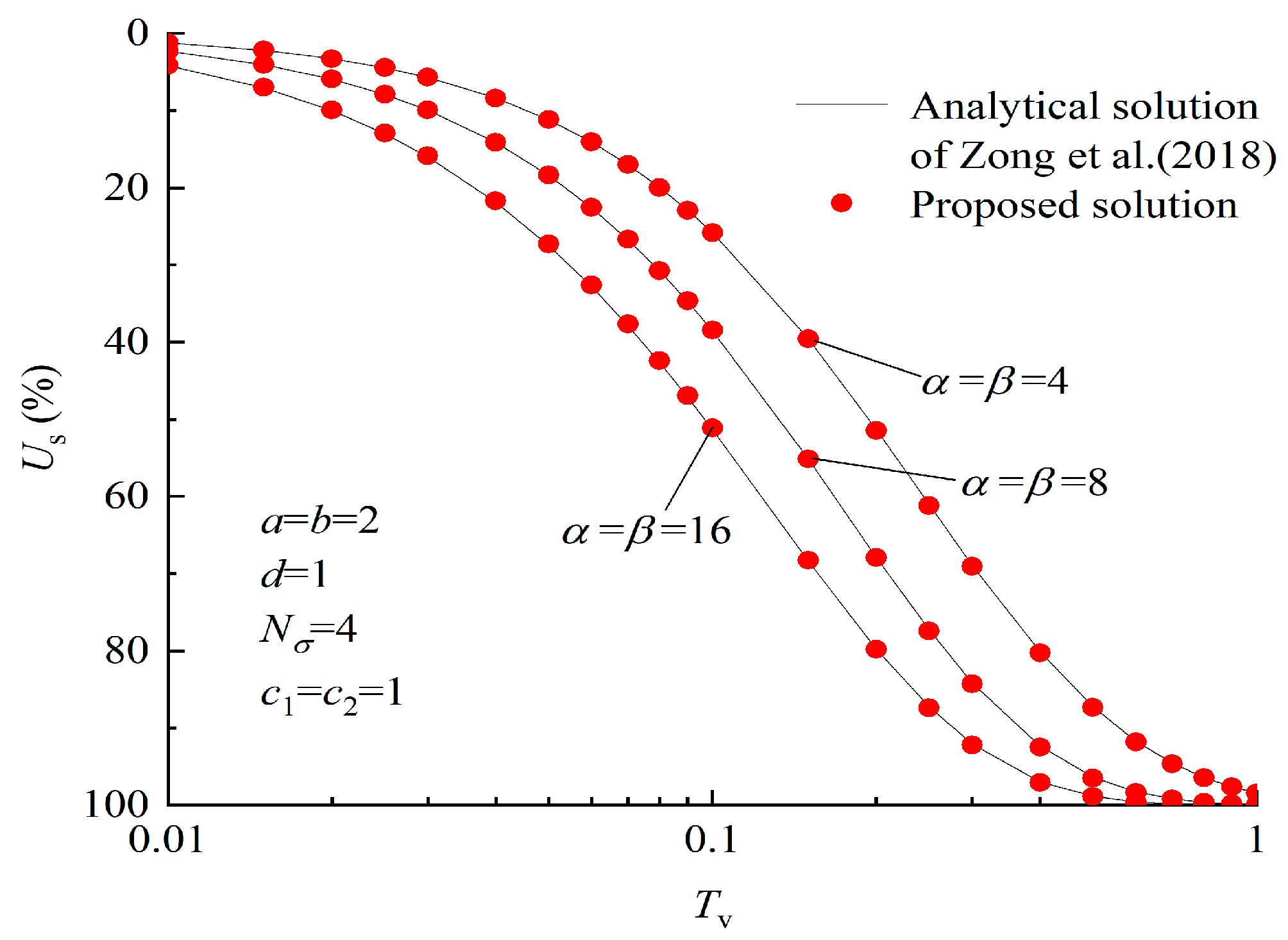

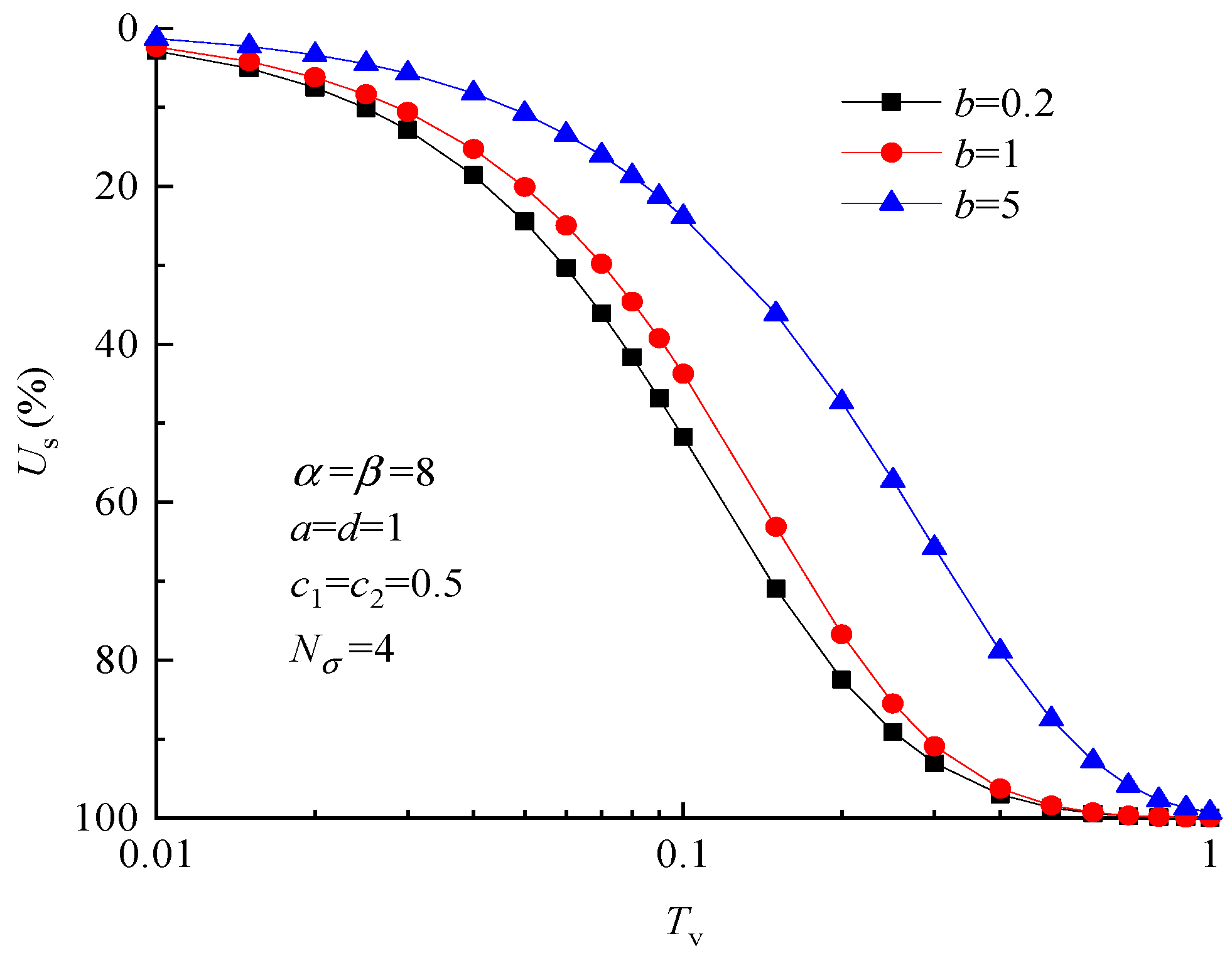

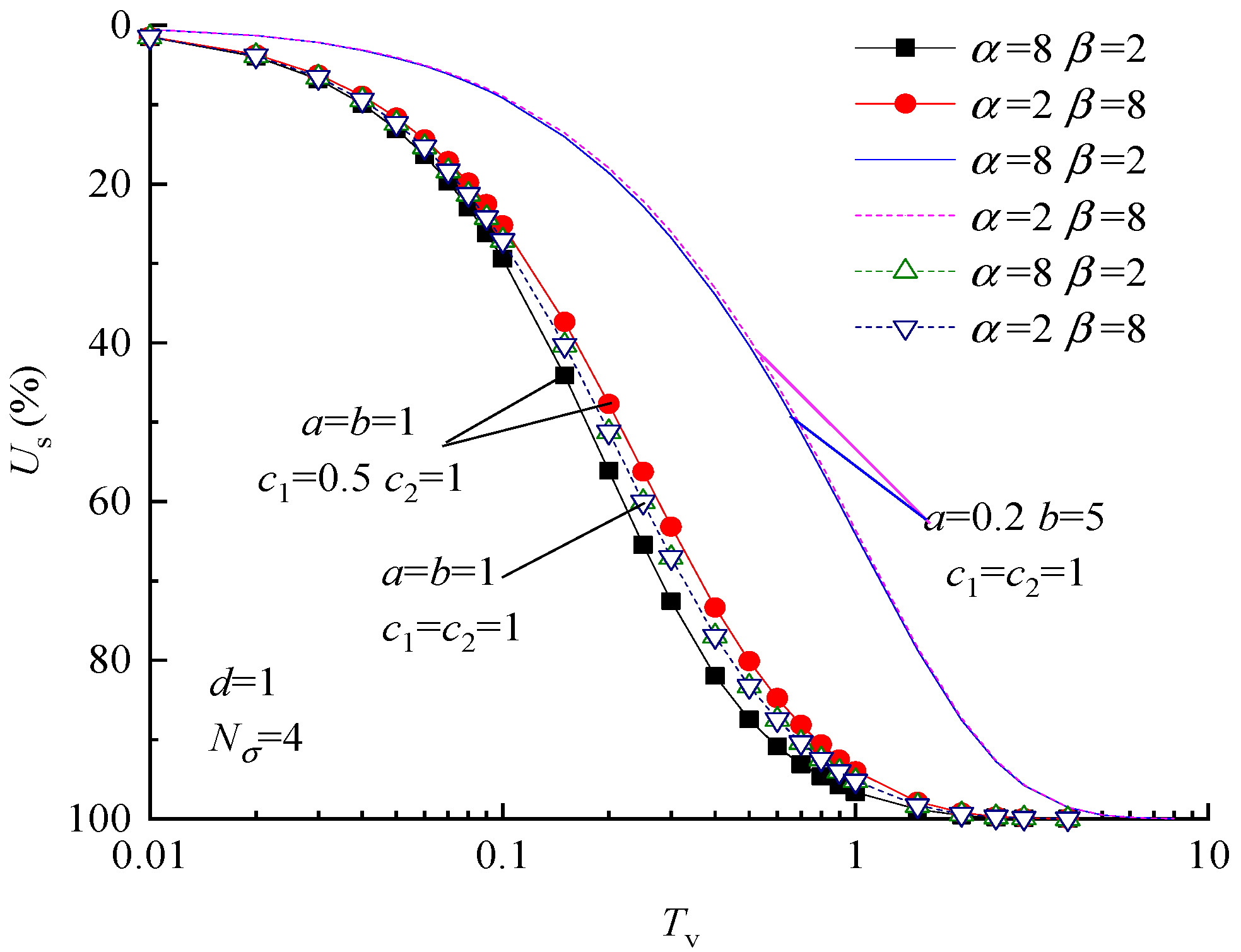

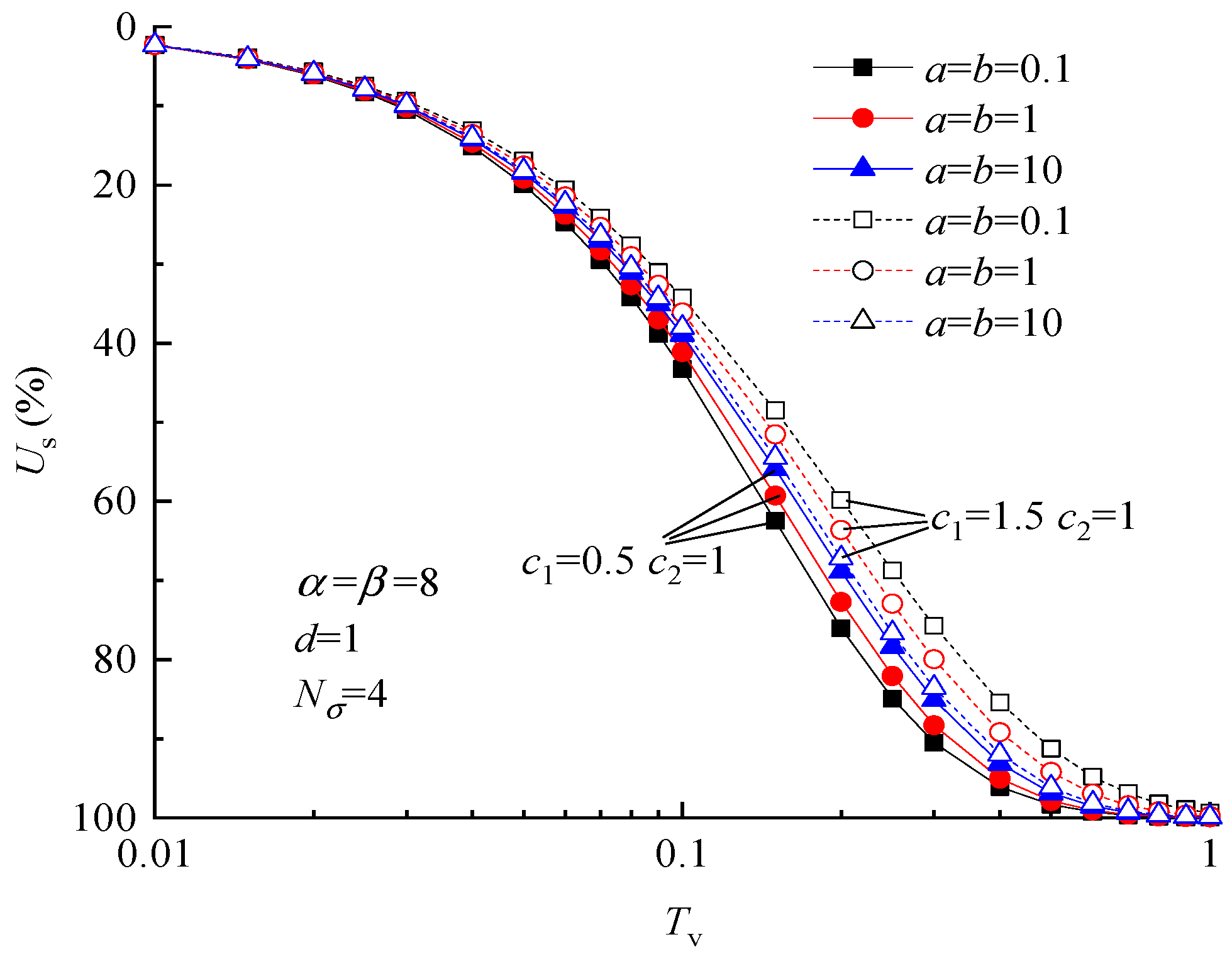
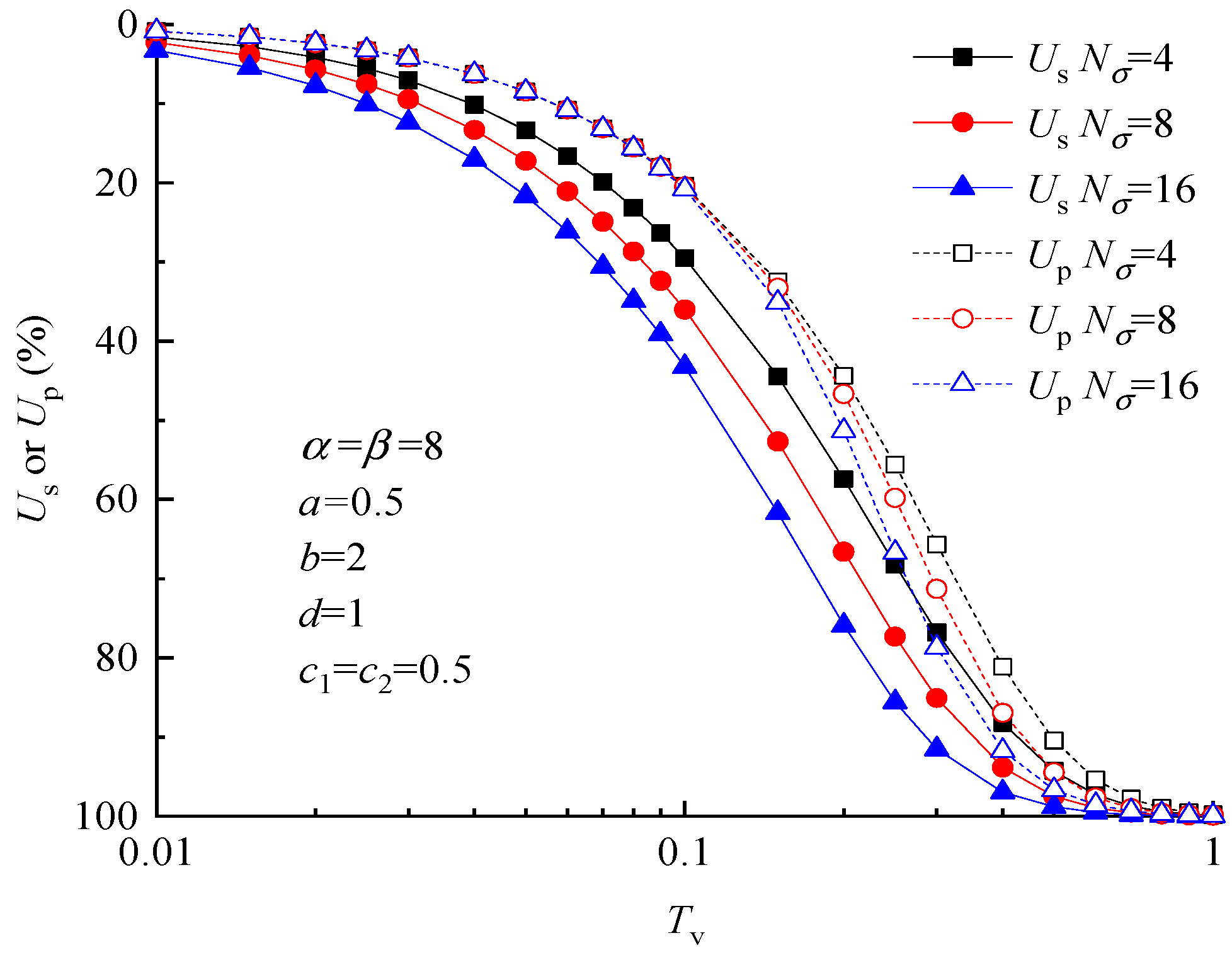


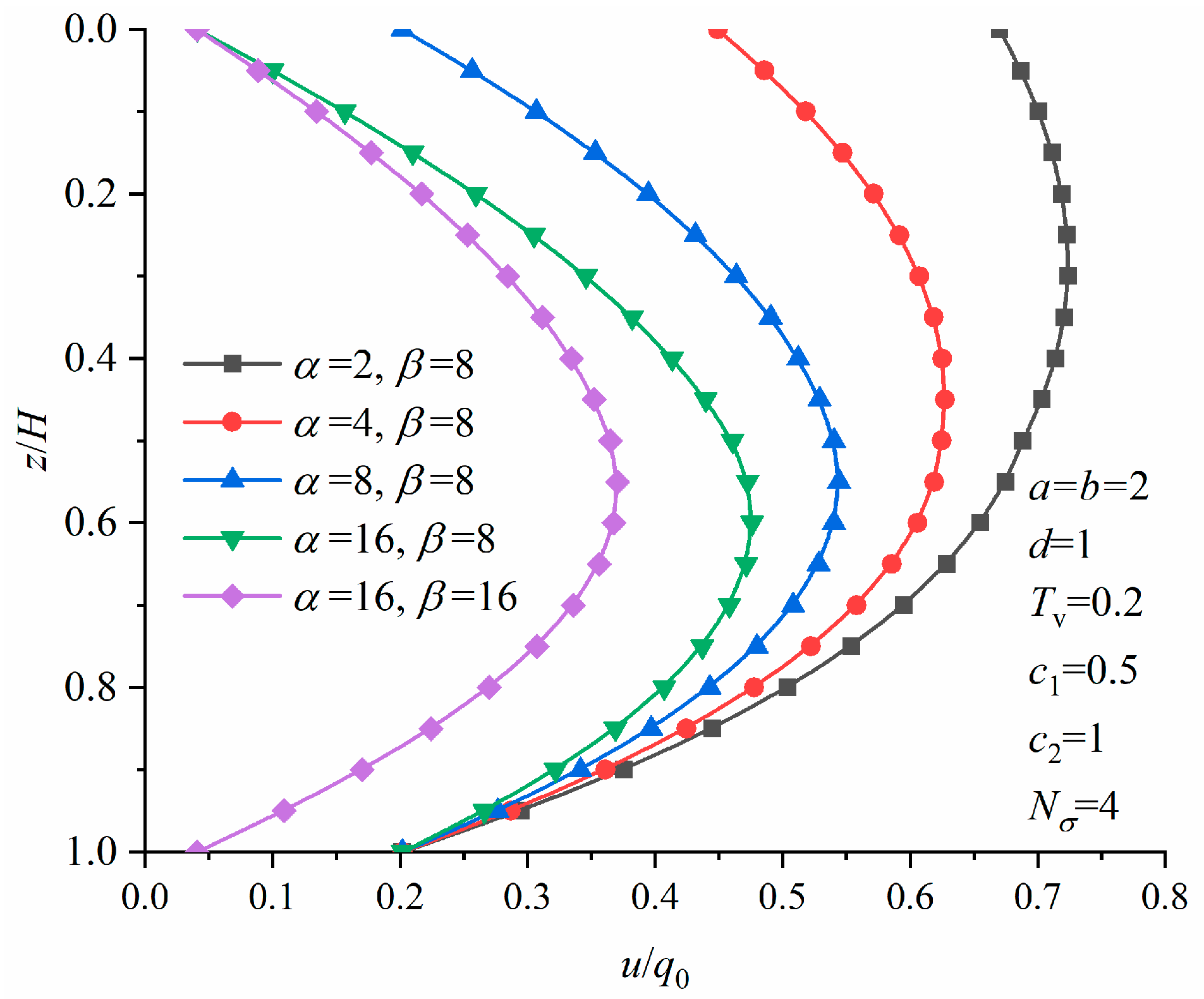



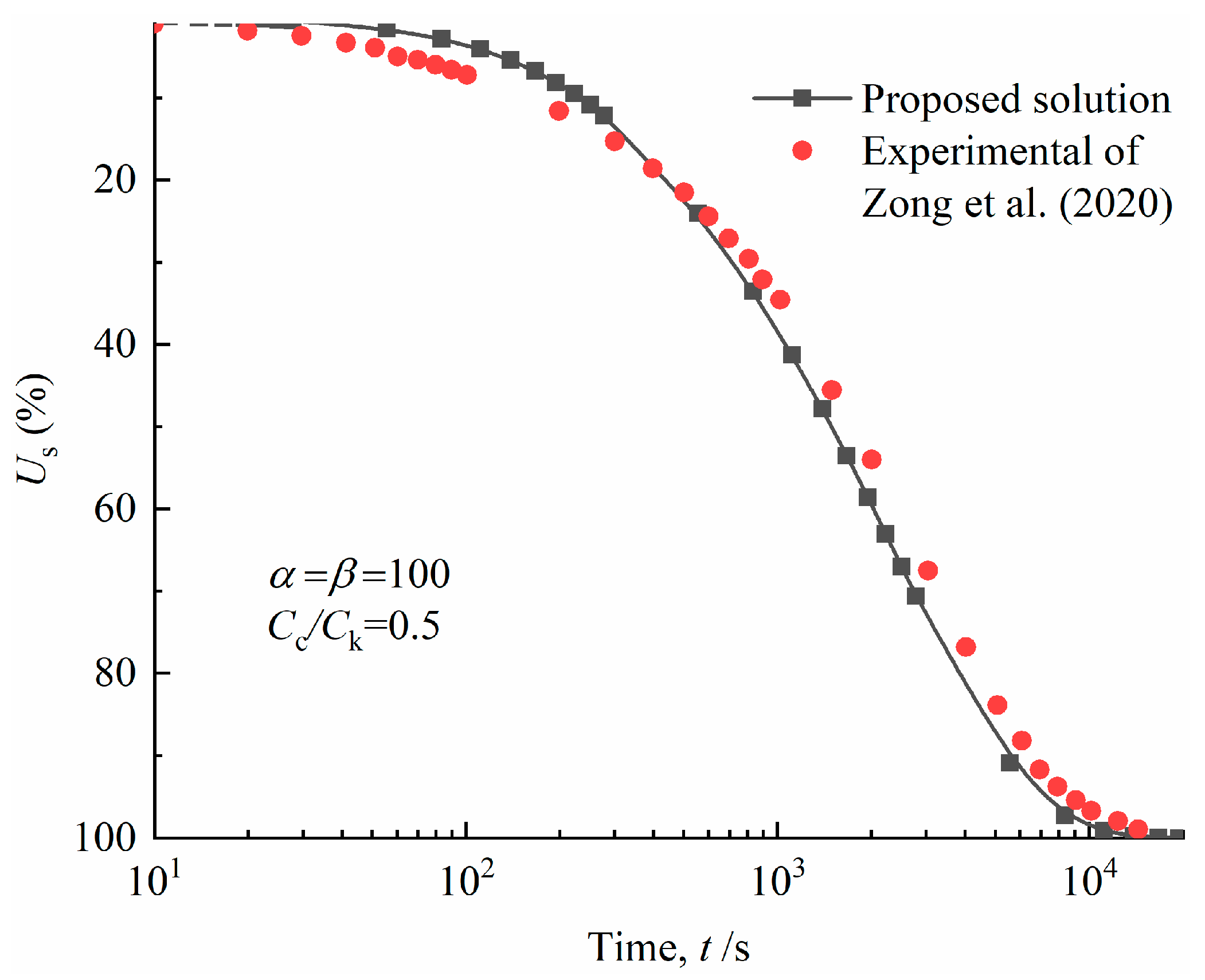
| Soil Layer | Thickness h (m) | Load P (kPa) | Initial Effective Stress (kPa) | Compression Index Cc | Penetration Index Ck | Initial Permeability Coefficient kv0 (10−9 m·s−1) | Initial Void Ratio e0 | Initial Compression Modulus Es0 (kPa) |
|---|---|---|---|---|---|---|---|---|
| Upper soil | 5 | 100 | 20 | 0.315 | 0.525 | 0.815 | 1.422 | 354.086 |
| Lower soil | 0.528 | 0.880 | 6.15 | 1.622 | 228.689 |
| (kPa) | e0 | mv0 (MPa−1) | kv0 (×10−7 cm/s) | cv0 (×10−3 cm2/s) | Nσ | H (cm) |
|---|---|---|---|---|---|---|
| 253–453 | 0.694 | 0.39 | 0.61 | 1.59 | 1.79 | 6.65 |
Disclaimer/Publisher’s Note: The statements, opinions and data contained in all publications are solely those of the individual author(s) and contributor(s) and not of MDPI and/or the editor(s). MDPI and/or the editor(s) disclaim responsibility for any injury to people or property resulting from any ideas, methods, instructions or products referred to in the content. |
© 2023 by the authors. Licensee MDPI, Basel, Switzerland. This article is an open access article distributed under the terms and conditions of the Creative Commons Attribution (CC BY) license (https://creativecommons.org/licenses/by/4.0/).
Share and Cite
Zhang, Y.; Yin, Y.; Zong, M.; Wu, W.; Zong, Z.; Mei, G. A One-Dimensional Nonlinear Consolidation Analysis of Double-Layered Soil with Continuous Drainage Boundary. Appl. Sci. 2023, 13, 11711. https://doi.org/10.3390/app132111711
Zhang Y, Yin Y, Zong M, Wu W, Zong Z, Mei G. A One-Dimensional Nonlinear Consolidation Analysis of Double-Layered Soil with Continuous Drainage Boundary. Applied Sciences. 2023; 13(21):11711. https://doi.org/10.3390/app132111711
Chicago/Turabian StyleZhang, Yi, Yong Yin, Mengfan Zong, Wenbing Wu, Zhongling Zong, and Guoxiong Mei. 2023. "A One-Dimensional Nonlinear Consolidation Analysis of Double-Layered Soil with Continuous Drainage Boundary" Applied Sciences 13, no. 21: 11711. https://doi.org/10.3390/app132111711





